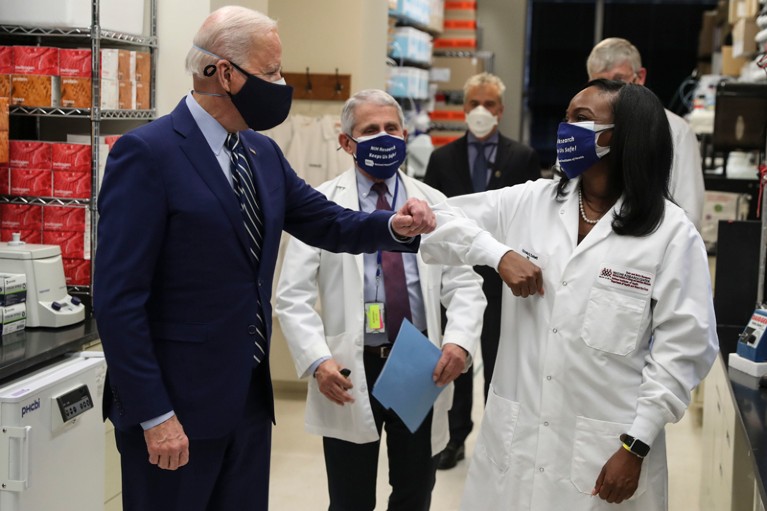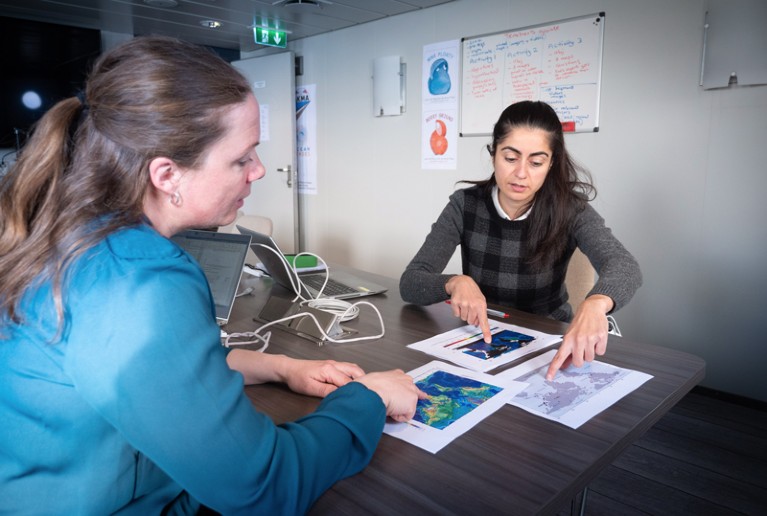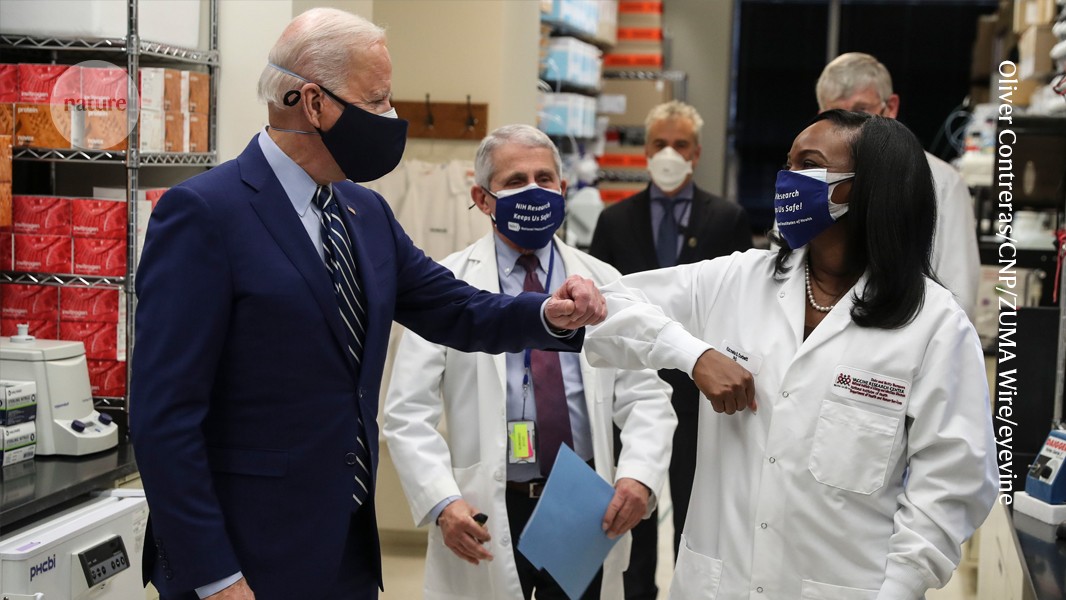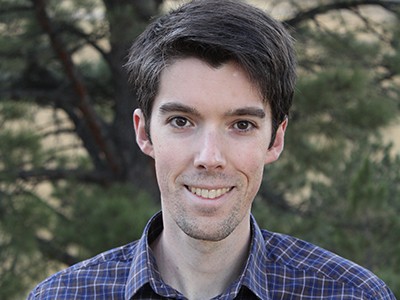
Kizzmekia Corbett-Helaire explained her research on vaccines to US President Joe Biden during his visit to the National Institutes of Health.Credit: Oliver Contreras/CNP/ZUMA Wire/eyevine
Kizzmekia Corbett-Helaire found herself rising to a science-communication challenge at the start of the COVID-19 pandemic — striving to inform the public about the virus and the vaccine she was developing with biotechnology firm Moderna. An immunologist at Harvard T.H. Chan School of Public Health in Boston, Massachusetts, she was featured in news reports and posted videos on social media. In 2021, Corbett-Helaire was one of three scientists who took over Michelle Obama’s Instagram account for a day to answer questions from the former First Lady’s 57 million followers about vaccines, just as they were being rolled out to the public.
Today, she’s still doing research on viruses and vaccines. And she’s also continuing to use her background and platform to make science accessible to the general public.
But Corbett-Helaire says that she finds funding opportunities for science communication sparse — especially compared with those in her areas of research. She says that although she has received some funding that she can put towards financing the videos she posts on social media, many funders prefer work that has some sort of visible output or data endpoint. This is difficult to achieve for science communicators because impact measurements aren’t always that straightforward. And when there are funding opportunities, they’re often not for science communication specifically.
Climate researchers need support to become scientist-communicators
Science communication can come in many different forms — writing, teaching or just using social media. The overarching goal is to making science accessible to a larger and not necessarily science-literate audience. Despite the pandemic revealing the importance of such outreach, Corbett-Helaire and others who spoke to Nature agreed: public engagement still isn’t incentivized on a broad scale. It’s something that researchers often do as a labour of love.
In one 2020 study that surveyed more than 6,000 scientists at US universities, most respondents reported being involved in some sort of science communication1. A little over half said that public-engagement activities were important to them. However, when asked about how their institution and colleagues valued public engagement, many felt a lack of institutional support.
“It’s treated like charity,” Corbett-Helaire says. “Even though [science communication] is extremely important, it’s never rewarded,” agrees Lina Pérez-Angel, a palaeoclimatologist at Brown University in Providence, Rhode Island. In 2015, Pérez-Angel co-founded the bilingual science-communication platform GeoLchat. The Spanish and English platform aims to uplift and communicate the work of Earth scientists, particularly in Latin America and the United States. “It’s part of your free time,” she says about science communication.
What funding exists?
But some funding is available and scientists can look for financial backing for their engagement work through various avenues.
Groups such as the European Geosciences Union (EGU), the Genetics Society and the Royal Society of Chemistry, both in the United Kingdom, and the American Society for Biochemistry and Molecular Biology (ASBMB) provide small grants to fund science-communication projects by their members. The Natural Sciences and Engineering Research Council of Canada’s PromoScience Program awards funds to both non-profit organizations and researchers at post-secondary-school institutions that promote natural sciences and engineering to young Canadians. The UK Natural Environment Research Council awards projects that engage the public with environmental-science research. Major philanthropic organizations such as the Bill & Melinda Gates Foundation in Seattle, Washington, and the Gordon and Betty Moore Foundation in Palo Alto, California, have also funded science outreach projects.

Solmaz Mohadjer (right) says that receiving funding for science communication reinforces the feeling that what you are doing is important.Credit: Davide Oddone
Many organizations also emphasize science communication through their programming and fellowships, such as the American Association for the Advancement of Science. And some funds are also devoted to how to communicate science effectively, such as the US National Science Foundation’s (NSF’s) Science of Science: Discovery, Communication and Impact programme.
Certain funders also offer money to their existing grant holders for science-communication activities. The European Research Council, which funds more than 1,000 researchers at European Union host institutions annually, awards up to €10,000 (US$10,900) extra to six ERC-funded researchers for public engagement. The Volkswagen Foundation, a major funder in Hannover, Germany, gives up to €150,000 for science-communication projects to existing foundation grant recipients. “There are always researchers that have great ideas to do some science communication and we think it’s an important part of their jobs, and we want to support them,” says Selahattin Danisman, who runs the Volkswagen Foundation’s programme.
Furthermore, the NSF, which has a budget of about $10 billion and accounts for about 25% of all federally funded research at US colleges and universities, now asks that grant applications outline “broader impacts”, which can include work in science communication.
What institutions can do to improve science communication
But researchers who spoke to Nature add the caveat that for schemes such as that of the NSF, the money is often an addition to funding for lab research, rather than for running separate science-communication projects. And there isn’t enough, says Dan Killam, an environmental scientist in California. “Sometimes science communication can fit in, but it’s usually not the main part of their evaluation scoring rubric,” he says. “It’s something that everyone agrees is good, but when the rubber hits the road, it’s not really what’s going to change the decision of who’s funded.”
Researchers also say that there is a lack of institutional or widespread funding — or support — solely for science communication. A study of about 500 US scientists2 found that a majority participated in outreach . Nearly two-thirds of respondents participated in science outreach at least three times a year, and 94% of respondents agreed that it’s an effective tool for building community relationships. But many also cited barriers. Lack of time was the most common barrier among those involved in science outreach. And sparse funding was also a significant barrier for 49% of respondents.
How to find funding
Despite this, some researchers are finding ways to secure fair payment and recognition for their outreach work. Many suggest trying to integrate science communication as much as possible into day-to-day research work.
“I generally still have no regrets about pursuing it as a focus,” says Killam. “I think my science communication has made me a better scientist, doing better, more impactful work. Talking to the public helps me hone my research questions and how I communicate them, which helps my grant applications!”
Because Pérez-Angel receives NSF funding for her academic research at Brown, she was also able to integrate a request for science-communication funding as part of the ‘broader impacts’ section of the grant. She was awarded $2,000 for ‘materials’ for all her outreach and activities, including curriculum development for primary and secondary education, video productions and translator fees.
She tries to fit science-communication activities into her working day — between meetings, writing papers and data processing. But sometimes she ends up working on it after hours, in the evening, to allow enough time to get the work done.
“Science communication is as real and as hard as doing research,” she says. Pérez-Angel encourages other researchers who get funded by the NSF to add money to their proposals that can go towards outreach. She also recommends finding out what a researcher’s associated society offers. In her research area, both the Paleontological Society in the United States and the American Geophysical Union have small grants ($2,500 and $1,000, respectively) that members can apply for to fund a community-engagement project.
Solmaz Mohadjer, a geoscientist and lecturer at the University of Tübingen, Germany, has received a similar grant. In 2016, she received 12-month public-engagement funding worth €1,000 from the EGU to finance a series of short videos for teachers to use in their classrooms. Mohadjer was one of the first people to win the organization’s public-engagement grant after its introduction in November 2015. The money helped kick-start her project, but also helped to affirm that her work was appreciated.
Why you should perform a premortem on your research
“What is really important about this grant is that you have the formal recognition that says ‘what you’re doing is important, what you’re doing matters,’” she says. “[They’re saying] ‘we recognize that, we award that, we highlight that, what comes out of your project, we will help you, and will support you to disseminate that.’”
She is now part of the EGU outreach committee and advises anyone planning a project to start by setting out in detail what they hope to achieve — rather than simply diving in.
“[Scientists should] take it as seriously as they take their research,” she says. “The most important thing is to make sure they know what the objective of the science-communication initiative or project is.” Projects also need to consider who the audience is and the format — how can you reach the audience effectively?
Being pragmatic is also key. “Sometimes researchers will have great ideas but it’s not realistic, either in terms of how much time they think it will cost them, or how much money it will cost them,” says Danisman.
It’s also important to think about how to demonstrate impact to secure further funding and recognition. Mohadjer recommends aiming for both qualitative and quantitative data that show the effectiveness of the project. One good example, she says, is SUstaiNability, a science-communication website for environmental research designed by researchers from the University of Campania Luigi Vanvitelli in Naples. To demonstrate their programme’s effectiveness, the researchers published a quantitative analysis of the reach and impact of different social-media channels used for communicating natural-hazard information. Pérez-Angel recommends that individuals track data before and after science-communication efforts — this could be social-media likes and followers, website visits and views, or in-person attendance of an event. Killam says that he has sometimes asked for testimonial letters from teachers he has talked to, or students he has mentored, who can speak to the effectiveness of his science communication.
Those Nature spoke to also stressed the importance of collaboration — both with scientists and with organizations. PromoScience’s Carolyne Bjerring, a programme manager in Ottawa, says that “Each application needs to come with supporting letters to demonstrate that they’re working with either different communities or to demonstrate some of the previous work that they’ve done in science promotion.”
Christina Swords, the chair of the science outreach and communication committee at the ASBMB in Rockville, Maryland, also stresses the importance of partnerships. “If you’re an undergraduate student and you want to communicate science in an under-resourced school, would a non-profit that works regularly with that school have more insight into ways that you can then fill a gap?”, she says.
After all, science communication is supposed to bridge gaps that exist between researchers and the public — making it accessible for all. But it has benefits beyond just connecting the public to research.
“As scientists, when we actually engage with the public and do science communication, we become better scientists,” Mohadjer says. “We grow as scientists, because through that engagement, we are also improving our communication and organizational skills.”





